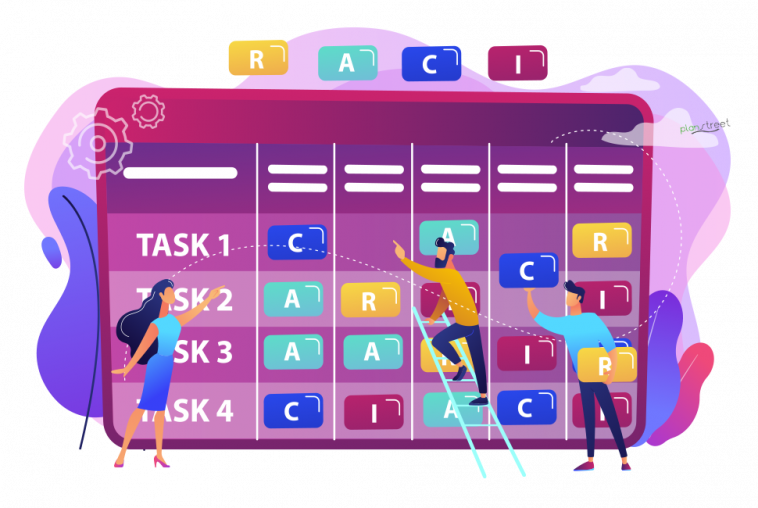Close familiarity with the roles and responsibilities helps team members to run the project smoothly. Therefore, exchanging task details on the initial stage is crucial. A RACI chart or matrix helps to make these definitions clear to the team and define roles and responsibilities. It’s an effective way to ensure a similar wavelength and transparency, as the last thing you expect when administering a project is confusion. Creating a RACI matrix sometimes become a bit of a beast, with jumbles for the allocation of tasks.
The RACI chart helps to make the process easier but can be the chaos in the room at the beginning of the project.
What Is the RACI Chart?
RACI stands for responsible, accountable, consulted, and informed. This chart is a means to allocate works to the team members and defines their roles. It’s a tool to identify roles and responsibilities against tasks within a project. It helps to bring clarity in the project and avoids any type of confusion, which can lead to a slow production rate or eat into costs.
Let’s discuss what RACI stands for and the significance of each of these words:
Responsible
There must be at least one responsible team member who does the work to ensure the completion of the task. However, It’s fine to have more than one responsible person. This person actions the task and is responsible for finishing the work or taking the decision. But it is advisable to minimize the number of people involved.
Accountable
Here the person is in charge of assigning tasks and approves deliverables before the end of the completion process. Sometimes the responsible person is also the accountable one. But the involvement of one accountable person in the task is essential. The person will be accountable for the overall completion of the task or deliverable. The purpose is not to complete the work but to make sure the effective completion. It is ideal for assigning one person for this work rather than a group to avoid confusion.
Consulted
Here the work is to review a deliverable and giving feedback. The information given by this person or group is valuable for completing the task. There will be two-way communication between the responsible and consulted ones.
Informed
Here the member must be aware of the different events of the execution process but are not liable with the same level of responsibility as those listed above. They just need to have the up to date information about the general report on progress. The one-way communication to these roles or groups is necessary.
The Advantages of A RACI Chart
Streamlining Communication
RACI Chart helps to refer back to the whole life of a project. Instead of involving all team members in the decision-making process, you can involve the right people at the right time and speed up the decision-making process.
Avoiding People Overload
Getting opinions from all team members can create confusion as it is difficult to incorporate everyone’s point of view. Here RACI Chart comes into the picture. The benefit of task separation between the Consulted and Informed is that you can easily identify those involved in the feedback process and those responsible for the task done.
Setting Clear Expectations
You can easily enhance performances using a RACI chart on your project. This chart helps to allocate tasks and set expectations for who is liable for work completion. Team members should be able to recognize their work and responsibility. It can also help to avoid confusion by acknowledging who is ultimately responsible for task completion.
When Should I Use A RACI Chart?
We can’t use the RACI chart for all projects. If we incorporate complex levels to some small and fast-moving projects, it will slow things down and create blockers. You don’t require a RACI chart if
- Your project team is small
- Roles are already clearly set.
- Your organization successfully use similar structure previously
In the above circumstances, you just need to assign tasks to people. You don’t need to fix everyone’s involvement in every task.
But not using a RACI Chart can lead to difficulties further down the line if you are working on larger projects with multiple stakeholders. It helps to avoid surprises and excess involvement from the stakeholders. Primarily, it helps to clear the confusion of roles and responsibilities distribution.
How to Create A RACI Chart
All projects can use a RACI chart and enjoy the benefit from the set expectations. It helps to manage multiple resources or having task dependencies. To clearly understand the process of making a RACI chart, let’s build a project. You’re constructing an addition to your home, and the following steps will outline how you create a RACI chart:
Step One: Identify Roles
First of all, you need to list all the people involved in the project, including the client or homeowner. There will be an architect who is responsible for drawing up the plans. Then there will be someone to oversee the whole project from start to finish. Then comes a contractor who is responsible for the actual construction with many other subcontractors, such as electricians, roofers, etc.
Reasons to define by role:
- If a particular person is performing many functions
- It avoids the obligation to update with a change in personnel.
- It avoids confusion and broader groups, e.g., ‘client’ or ‘unit X.’
Step 2: Identify Project Tasks or Deliverables
Next, you need to create a defined list of all the tasks, including milestones. Note the decision-making steps required for these tasks on the far-left column. It can involve evaluating the projects by the architect, calculating the budget, obtaining permits, developing the site, and doing the necessary excavation.
Step 3: Assign RACI to Each Role and Task
Allot the R (Responsible), A (Accountable), C (Consulted), or I (Informed) unit for each role and task. For instance, the architect would be responsible for the project plan, and the accountable one would ensure that plan is progressing without any regulatory issues. To ensure specifications, the client would manage the Consulted unit, and so on.
Quick Tips to Make Your RACI Chart Succeed
- Ensure the implementation of a RACI Chart produces beneficial outcomes for your project; you can do so by analyzing the different usage of RACI Chart.
- Select the best suitable model for your project and understand its terms.
- Mark only one role as Accountable instead of an entire group to ensure sole control. Many members can create confusion in the project and slow down the process.
- Not everyone requires being in the informed section as it’s only for those that have an impact on the project or vested interest.
- Don’t make the draft of the RACI Chart all by yourself involve the core project stakeholders too.
What Are The Alternatives To A RACI?
RASCI
The most effective alternative of RACI is the RASCI chart (Responsible, Accountable, Supportive, Consulted, Informed). The Supportive unit works with the Responsible team member and helps to complete the task. The difference between Supportive and Consulted is that the latter will
RAS
RAS is popular for its simplification and stands for Responsible, Approve, and Support. But lack of account for the owner of the task creates confusion.
DACI
DACI chart is comparatively similar to RACI, but it exchanges Responsible and Accountable for drivers and Approvers. It helps to simplify things and avoid confusion but focuses more on actions.
CLAM
CLAM stands for Contributes, Leads, Approves, Monitors, and focuses more on actions instead of roles like DACI.
The changes in the RACI are more about fixing the terms with more precision or defining roles further so that any doubtfulness between roles is eradicated. There isn’t an enormous distinction between the RACI and other alternatives in terms of what they are striving to accomplish, so you can just analyze the models and then select which suits the project best.





